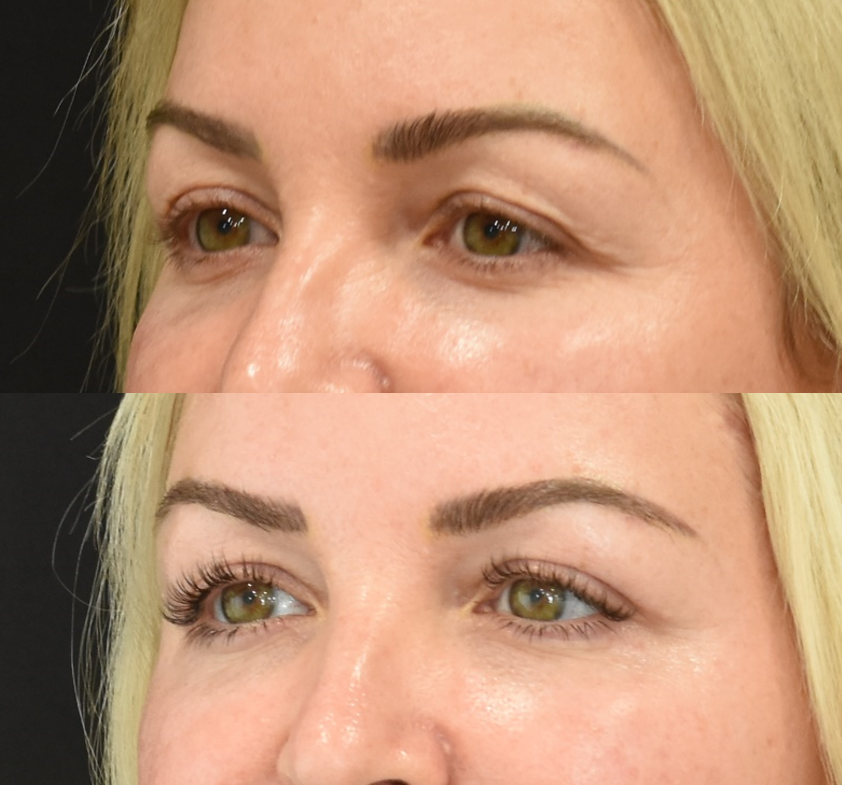Brow Lift

The lateral temporal brow lift is a surgical procedure that can restore youthfulness to drooping lateral eyebrows. It places the descended brow in a more natural position compared with many other approaches to avoid imparting a "surprised" appearance to the face. The procedure is tension-free and, therefore, can be longer lasting than many other approaches. It also requires only two small incisions just behind the temporal hairline.
Lateral Temporal Lift (Brow Lift) Before & After

Am I a good candidate?
Candidates for a lateral temporal brow lift, also called a brow lift, can include those who exhibit drooping of their eyebrows, often resulting in a “sad,” “tired,” or even “angry” appearance. This can cause distress in social environments. Most candidates range in age from 30s to 70s.
A consultation is essential to determine candidacy for the procedure, because there may be factors that preclude this procedure for certain individuals. Furthermore, plastic surgery of the eyebrows can produce varying results. A consultation will help establish reasonable expectations about what a brow lift can and cannot accomplish as well as any anatomic and/or physiological factors that may influence your results. As with all facial plastic surgery procedures, results can vary.
Expected recovery
Recovery from a brow lift is specific to the individual. The duration of recovery will vary from person to person. The recovery time from a brow lift procedure is approximately 7 to 10 days for most individuals.
Suture (stitches) are removed in a staged, progressive fashion over the first 7 to 10 days after surgery. Sometimes, all of the sutures are left in for 10 days. The healing process does not end at 10 days, however. For example, the incisions continue to heal for months after surgery.
Some swelling and bruising are expected after a brow lift. Post-operative swelling and bruising generally improve significantly by 7 to 10 days after surgery. Swelling and bruising around the incisions are expected to continue to improve and resolve in the ensuing days and weeks.
Consultation
Expect a detailed, informative conversation with Dr. Harmon about your concerns and aesthetic goals regarding your eyebrows. He will assess your anatomy and develop a personalized treatment plan to address your concerns and aesthetic goals.
Frequently asked questions
- What type of anesthesia is required?
- The lateral temporal brow lift can usually be performed under IV sedation. Some individuals may require general anesthesia.
- Can the brow lift (Lateral temporal lift) be performed as a standalone procedure or must it be performed with other procedures?
- The brow lift (lateral temporal lift) can be performed either as a standalone procedure or with other procedures. However, it is potentially a powerful complement to the extended deep plane facelift, neck lift, and lip lift in addressing the signs of aging of the face comprehensively.
- Will a brow lift (lateral temporal lift) make me look “surprised” or unnatural?
- The lateral temporal lift technique is designed to prevent a “surprised” appearance. The technique allow precise, tension-free repositioning of the brow in order to provide a more natural result.
- Will my hairline change?
- The incisions for the brow lift (lateral temporal lift) are placed within the hair just behind the temporal hairline. Skin and hair is generally not removed for this procedure unless a specific aesthetic goal is desired. However, some hair thinning can occur around the incisions which is usually temporary.
- Can my medial brow be address as well?
- Yes. In fact, there is evidence that the lateral temporal brow lift can lift the medial brow up to 3 mm in some cases. The medial brow can be lifted higher through an additional small incision that is hidden within the hair.
- How does the lateral temporal brow lift relate to upper eyelid (blepharoplasty) surgery?
- The lateral temporal brow lift complements and enhances the effects of upper eyelid (blepharoplasty) surgery by lifting the lateral eyebrow and smoothing the side of the eye out in the area that is continuous with the upper eyelid.
- Can I undergo a brow lift after Botox© treatment to my forehead and frown lines?
- It is important that any Botox© or other botulinum toxin treatment to the forehead, frown lines, and/or crow's feet has worn off prior to undergoing a brow lift. This is because the position of the eyebrows may change temporarily after Botox© administration which could make the position to which the brows are lifted too high or low.
- Is the brow lift a painful procedure?
- Facial plastic surgery procedures are generally well-tolerated by patients and typically involve little pain, especially when compared with surgery on other areas of the body. Patients are usually prescribed just a small amount of pain medication for after surgery. In fact, we have found most use only over-the-counter pain medication including acetaminophen and/or ibuprofen after surgery instead. And those who do use the prescribed pain medication usually only use it the first night after surgery. With that in mind, it is important to note that every patient perceives and processes pain differently. Some patients have a high pain tolerance. Others may be more predisposed to be more sensitive to pain. We at Harmon Facial Plastic Surgery are focused on balancing minimizing post-operative discomfort and maximizing safety.
- Is a brow lift a common surgical procedure?
- Yes, a brow lift is a common surgical procedure. The International Society of Aesthetic Plastic Surgery (ISAPS) releases statistics each year that provide insight into the state of plastic surgery around the world. ISASPS reported 31,404 brow lifts were performed in the United States in 2020.
Why Choose Dr. Harmon
- The mission of Harmon Facial Plastic Surgery is to help people along their journey towards self-confidence, to feel good about feeling good.
- Dr. Harmon is a double board-certified facial plastic surgeon.
- Dr. Harmon values making patients feel welcomed, listened to, and respected.
- Dr. Harmon graduated with honors from Cornell University with a Bachelor of Science degree in molecular biology.
- Dr. Harmon earned his medical degree from the University of Cincinnati.
- Dr. Harmon underwent five years of extensive training in head at neck surgery at the prestigious residency program at the University of Cincinnati.
- Dr. Harmon then underwent focused fellowship training in cosmetic facial plastic surgery through the American Academy of Facial Plastic and Reconstructive Surgery (AAFPRS) with the world-renowned surgeon, Dr. Andrew Jacono, on Park Avenue in New York City.
- Dr. Harmon posts frequently and covers a wide range of topics, including procedure-specific information, volunteering, general health, and much more. Read more from Dr. Harmon by visiting his blog.
- Harmon Facial Plastic Surgery can be reached here.
Additional Reading
- Article - History of Brow Aesthetics and Lateral Temporal Brow Lift
- Article - How Do Brow Lift Procedures Differ?
- Article - Three Procedures to Address the Signs of an Aging Face Comprehensively
- Article - How to Treat Drooping, Hooded Eyes That Can Make Use Look Tired
- Article - The Importance of Post-Operative Recovery Incision Care and Our Plan
- Article - Is Silicone Gel Effective in Improving the Appearance of Surgical Incisions?
- Article - What Makes a Facial Plastic Surgeon Qualified to Care for Your Face?
- Article - When Should I Consider Undergoing Facial Plastic Surgery Procedures Prior to a Wedding?
Disclaimer: This page is for educational purposes only and does not constitute direct medical advice. Moreover, this page should not be used as a substitute for direct medical advice. It is essential that you have a consultation with a qualified medical provider prior to considering any treatment in order to determine whether you are a candidate for treatment. This will also allow you the opportunity to discuss any potential benefits, risks, and alternatives to the treatment.
